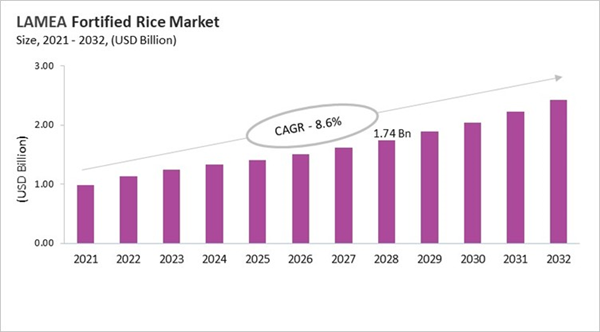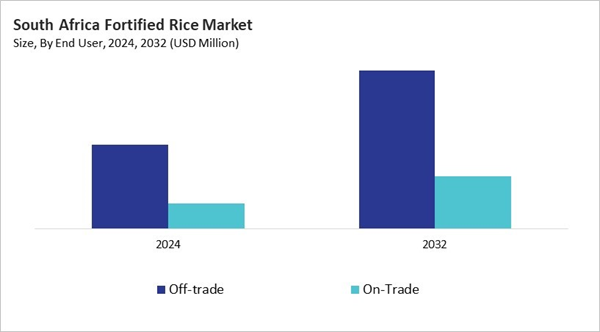The Latin America, Middle East and Africa Fortified Rice Market is expected to witness market growth of 8.1% CAGR during the forecast period (2025-2032).
The Brazil market dominated the LAMEA Fortified Rice Market by country in 2024, and is expected to continue to be a dominant market till 2032; thereby, achieving a market value of $420.1 million by 2032. The Argentina market is showcasing a CAGR of 8.6% during 2025-2032. Additionally, the UAE market would register a CAGR of 6.8% during 2025-2032. The Brazil and Saudi Arabia led the LAMEA Fortified Rice Market by Country with a market share of 19.9% and 14.5% in 2024.
Over the past 20 years, the market for fortified rice in Latin America, the Middle East, and Africa (LAMEA) has changed as a calculated reaction to hidden hunger and micronutrient deficiencies. Rice fortification has been incorporated into national nutrition policies, especially in high-consumption areas, under the direction of WHO, FAO, and WFP guidelines. Brazil and other countries adopted voluntary frameworks backed by quality-control systems and consumer awareness campaigns, while Costa Rica and Panama mandated fortification, making Latin America an early leader. Through WFP-supported school feeding programs, Nigeria emerged as a leading example in Africa, generating demand that prompted millers to make investments in extrusion technology. In the meantime, the Middle East is investigating rice fortification to reach low-income and migrant populations by utilizing its infrastructure for flour fortification.
Three main trends are reflected in market development throughout LAMEA: the integration of public procurement, changing regulatory frameworks, and technological advancements. By integrating fortified rice into humanitarian, social protection, and school feeding initiatives, demand has been stabilized, and private sector involvement has increased. Compliance and consumer trust have increased as a result of policy clarity, which is required in some regions of Latin America and is progressively becoming more prevalent in Africa and the Middle East. Fortified rice is now thriving in both institutional and retail markets thanks to improvements in affordability, scalability, and consumer acceptance brought about by advancements in extrusion technology. Fortified rice is moving from donor-driven pilots to sustainable, competitive markets that match long-term business viability with public health goals, thanks to partnerships between governments, OEMs, private millers, and international organizations.
The Brazil market dominated the LAMEA Fortified Rice Market by country in 2024, and is expected to continue to be a dominant market till 2032; thereby, achieving a market value of $420.1 million by 2032. The Argentina market is showcasing a CAGR of 8.6% during 2025-2032. Additionally, the UAE market would register a CAGR of 6.8% during 2025-2032. The Brazil and Saudi Arabia led the LAMEA Fortified Rice Market by Country with a market share of 19.9% and 14.5% in 2024.
Over the past 20 years, the market for fortified rice in Latin America, the Middle East, and Africa (LAMEA) has changed as a calculated reaction to hidden hunger and micronutrient deficiencies. Rice fortification has been incorporated into national nutrition policies, especially in high-consumption areas, under the direction of WHO, FAO, and WFP guidelines. Brazil and other countries adopted voluntary frameworks backed by quality-control systems and consumer awareness campaigns, while Costa Rica and Panama mandated fortification, making Latin America an early leader. Through WFP-supported school feeding programs, Nigeria emerged as a leading example in Africa, generating demand that prompted millers to make investments in extrusion technology. In the meantime, the Middle East is investigating rice fortification to reach low-income and migrant populations by utilizing its infrastructure for flour fortification.
Three main trends are reflected in market development throughout LAMEA: the integration of public procurement, changing regulatory frameworks, and technological advancements. By integrating fortified rice into humanitarian, social protection, and school feeding initiatives, demand has been stabilized, and private sector involvement has increased. Compliance and consumer trust have increased as a result of policy clarity, which is required in some regions of Latin America and is progressively becoming more prevalent in Africa and the Middle East. Fortified rice is now thriving in both institutional and retail markets thanks to improvements in affordability, scalability, and consumer acceptance brought about by advancements in extrusion technology. Fortified rice is moving from donor-driven pilots to sustainable, competitive markets that match long-term business viability with public health goals, thanks to partnerships between governments, OEMs, private millers, and international organizations.
End User Outlook
Based on End User, the market is segmented into Off-trade (Supermarkets & Hypermarkets, Convenience Stores, Online stores, Specialty Stores, and Other Off-trade Type) and On-Trade. With a compound annual growth rate (CAGR) of 8.5% over the projection period, the Off-trade Market, dominate the South Africa Fortified Rice Market by End User in 2024 and would be a prominent market until 2032. The On-Trade market is expected to witness a CAGR of 9.9% during 2025-2032.Nutrient Outlook
Based on Nutrient, the market is segmented into Iron, Vitamin, Zinc, and Minerals. Among various UAE Fortified Rice Market by Nutrient; The Iron market achieved a market size of USD $125 Million in 2024 and is expected to grow at a CAGR of 6.3 % during the forecast period. The Zinc market is predicted to experience a CAGR of 7.4% throughout the forecast period from (2025 - 2032).Country Outlook
Brazil's fortified rice market has become a regional benchmark due to successful pilots like PATH/GAIN's partnership with Urbano, which demonstrated that fortified rice can compete on store shelves as a popular, "better-for-you" staple. The market is bolstered by record grain production, a robust modern retail network, and millers that can blend large quantities of grain in-line. Additionally, consumers are familiar with functional nutrition. While price sensitivity in low-income segments and making sure fortified rice is organoleptically identical to conventional rice continue to be obstacles, growth opportunities include institutional procurement, private-label expansion, and ready-to-heat formats. Millers, FRK, and premix suppliers, and brands adept at tying the health benefits of micronutrients to narratives are all competitors. Scaling fortified rice within Brazil's dynamic food system will depend on maintaining consumer trust through stringent quality assurance, labeling, and focused partnerships.List of Key Companies Profiled
- DSM-Firmenich
- BASF SE
- Cargill, Incorporated
- Olam International Limited
- General Mills Inc.
- Bunge Limited
- KRBL Ltd.
- Buhler Group
- LT Foods Limited
- Wilmar International Ltd
Market Report Segmentation
By End User
- Off-trade
- Supermarkets & Hypermarkets
- Convenience Stores
- Online stores
- Specialty Stores
- Other Off-trade Type
- On-Trade
By Category
- Conventional
- Organic
By Nutrient
- Iron
- Vitamin
- Zinc
- Minerals
By Country
- Brazil
- Argentina
- UAE
- Saudi Arabia
- South Africa
- Nigeria
- Rest of LAMEA
Table of Contents
Chapter 1. Market Scope & Methodology
Chapter 2. Market at a Glance
Chapter 3. Market Overview
Chapter 6. Competition Analysis - Global
Chapter 11. LAMEA Fortified Rice Market by End User
Chapter 12. LAMEA Fortified Rice Market by Category
Chapter 13. LAMEA Fortified Rice Market by Nutrient
Chapter 14. LAMEA Fortified Rice Market by Country
Chapter 15. Company Profiles
Companies Mentioned
- DSM-Firmenich
- BASF SE
- Cargill, Incorporated
- Olam International Limited
- General Mills Inc.
- Bunge Limited
- KRBL Ltd.
- Buhler Group
- LT Foods Limited
- Wilmar International Ltd










